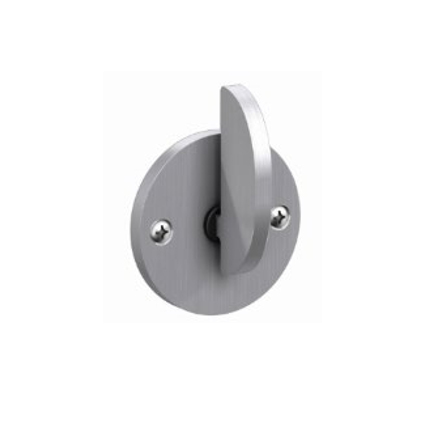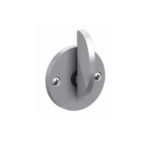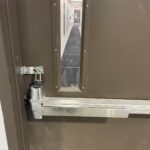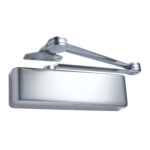At least once a month someone asks me whether it’s ok to use a deadbolt with a thumbturn on a door that is required to be accessible. It took some digging to get a definitive answer, because the accessibility standards don’t specify a certain dimension that would be acceptable for the thumbturn. The ADA guidelines and ICC A117.1 both state that hardware has to be operable without tight grasping, pinching, or twisting of the wrist, but that still leaves a lot up to interpretation.
Here’s the section from the 2009 edition of ICC A117.1:
404.2.6 Door Hardware. Handles, pulls, latches, locks, and other operable parts on accessible doors shall have a shape that is easy to grasp with one hand and does not require tight grasping, pinching, or twisting of the wrist to operate. Operable parts of such hardware shall be 34 inches (865 mm) minimum and 48 inches (1220 mm) maximum above the floor. Where sliding doors are in the fully open position, operating hardware shall be exposed and usable from both sides. EXCEPTION: Locks used only for security purposes and not used for normal operation shall not be required to comply with Section 404.2.6.
In my opinion, there are thumbturns that can be operated by someone with a disability, as long as the hardware is installed correctly (incorrect installation can cause binding and make the thumbturn difficult to turn). I requested a staff opinion from the ICC, and I was told that if you can operate the thumbturn with the side of your palm, without grasping it with your fingers, it would be considered accessible. I have also heard of code officials using the tip of a pencil to test the accessible operation of a thumbturn.
Many thumbturns are now designed so that they pivot from the end rather than the center, requiring less leverage to operate. The lock would also need to be mounted within the allowable range for operable hardware – typically 34 inches to 48 inches above the floor, and it would have to be the only lock on the door to meet the requirement that the door unlatch with one operation. If the door was fire-rated, a deadbolt would not provide the necessary positive latching, so a lockset or fire exit hardware with an active latchbolt would be required for that application.
Here are some thumbturns that are likely to be accessible if installed correctly:
Here are some thumbturns which may not be accessible (test operation with the side of palm):
You need to login or register to bookmark/favorite this content.









I agree with your assessment on accessible “thumbturns” (bottom-pivot, quarter-turn, lever-action deadbolts:), but I get a lot of push-back from about half of the building department. For years the only option for push/pull storefront doors was a keyed deadbolt with a sign. No thumbturns permitted! This is a big change for many inspectors.
You mention an ICC staff opinion. I’ve discussed this issue with a staff member who has written both egress and accessibility commentary, and she agrees with my (your) opinion. Did you write for a staff opinion and receive a written response on ICC letterhead? Or was this an email exchange with one staff member? The letter responses are usually vetted by management and represent a consensus opinion, so they carry a little more weight. If you have a written ICC response, I’d really like to have a copy. I’ve been arguing this issue off and on for close to 10 years and would like to put it to rest. Thanks for your insights into hardware issues.
Hi Tod –
The ICC opinion was via email – not a formal interpretation. I’ve run into this issue with code officials before but they usually accept the thumbturns that can be operated by the side of their palm. This blog post was actually written because someone needed back-up when trying to educate a code official on the requirements. Sorry I don’t have anything formal.
– Lori
Can you tell me where to find the accessible thumbturns? I would like to spec them.
Hi John –
It depends on which manufacturer you are specifying, but for Schlage they are shown on page 15 of this catalog: http://us.allegion.com/irstdocs/catalog/102899.pdf
– Lori
EXCEPTION: Locks used only for security purposes and not used for normal operation shall not be required to comply with Section 404.2.6.
I don’t know when locks are not used for security purposes. I thought that’s what locks were for.